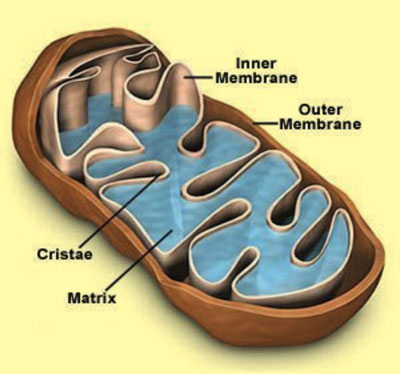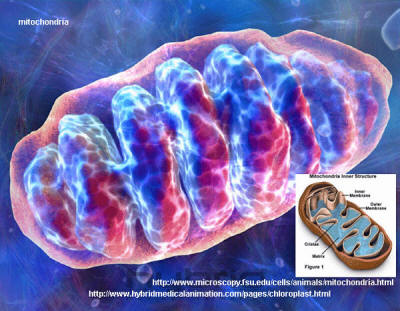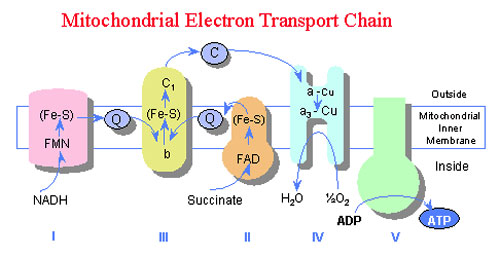|

by STAFF - Matheus
May 23, 2013
from
DrSircus Website
Spanish
version

Mitochondria
Inside
Dr. Terry Wahls
learned how to reverse accelerating multiple sclerosis using an
evidence-based, functional medical approach focusing on
orthomolecular nutrients and nutrition.
Using the lessons she
learned at the sub-cellular level, she used diet to cure
her MS and
get out of her wheelchair.
Her TED talk is quite
convincing:
Contemporary medicine has not understood the basics of mitochondrial
physiology.
Most doctors have no idea why,
-
magnesium
-
bicarbonate
-
selenium
-
sulfur,
...are important to the
mitochondria.
But basic science knows
this so it is a wonder that information does not get out about what
to do to repair and fire up the mitochondrial energy factories of
the cells.
If too many
mitochondria fail, there is nothing that can be
done to prevent death. Any successful treatment can
only be to prevent too many mitochondria from failing.
The mitochondria are the power stations of our cells.
They are as important to
our lives and health as electrical power stations are to modern
civilization. We just cannot get along without them. If mitochondria
get severely damaged, they die. If cells lose their mitochondria,
they lose their power source, and they die. When enough cells die,
we die.
Mitochondria disease is not usually life threatening in an emergency
sense.
There are few infections that attack the mitochondria though
there are poisons like cyanide which will wipe out our energy
stations and kill us without much fanfare. The mitochondria are
extremely sensitive to heavy metals and general chemical insults.
If the mitochondria are
denied the basic nutrition they need to function, they cease to
function normally.
Dr. Majid Ali says,
“Injured
mitochondria mutate at much higher rates. Damaged mitochondria
are exhausted mitochondria. Exhausted mitochondria cannot
produce sufficient ATP molecules. An insufficient supply of ATP
molecules means insufficient energy. Insufficient molecular
energy means clinical chronic fatigue.”
These organelles are the
power generators of the cell, converting oxygen and nutrients into
ATP (adenosine triphosphate).
ATP is the chemical
energy "currency" of the cell that powers the cell’s metabolic
activities. This process is called aerobic respiration and is the
reason animals breathe oxygen.
Mitochondria work
by generating an electrical
potential and a pH gradient across that inner membrane.
The mitochondrion is different from other organelles [1]
because it has its own DNA and reproduces independently of the cell
in which it is found; an apparent case of endosymbiosis.[2]
They really are not
quite us in the sense that their genetic pool is outside of our own
DNA that make us uniquely us. Unlike nuclear DNA, mitochondrial DNA
doesn’t get shuffled every generation, so it is presumed to change
at a slower rate.

Mitochondria Image
Recent breakthroughs in our understanding of autism and other
neurological diseases are coming through mitochondrial research and
it is important to note that pharmaceutical drugs are mostly
mitochondrial poisons.
Mercury is a
mitochondrial poison.
Data suggest that
moderate levels of mercury administered over an 8 week period can
affect adversely the integrity of mitochondrial membranes.[3]
The field of pediatrics has been perverted by the vaccines and
endless antibiotics they have administered to their patients.
Pediatricians do the
unforgiveable when they inject mercury directly into children’s
veins and that is why I wrote and have always given away The Terror
of Pediatric Medicine.
The German cancer
researcher Dr. Paul Gerhard Seeger [4]
demonstrated in 1938 that in most cases cancer starts in the
cytoplasm, the jelly-like outer part of the cell, and especially in
the energy-producing mitochondria.
Here food fragments are
normally oxidized in a series of enzymatic steps called the
‘respiratory chain’. Seeger showed that in cancer cells this
respiratory chain was more or less blocked, especially at the site
of the important enzyme cytochrome oxidase.
Without it the cell can
produce energy only anaerobically like a fungal cell. This is very
inefficient and the resulting overproduction of lactic acid makes
the cell and the whole body overly acidic.
Seeger and others found that cancer cells utilize only between 5 and
50% of the oxygen of normal cells. The virulence of cancer cells is
directly proportional to their loss of oxygen utilization, and with
this to the degree of blockage of the respiratory chain. In 1957
Seeger successfully transformed normal cells into cancer cells
within a few days by introducing chemicals that blocked the
respiratory chain.
Seeger’s most important discovery was the certainty that that
certain nutrients, mainly from the vegetable kingdom, could restore
cellular respiration in low-virulence cancer cells and, with this,
transform them back into normal cells.
Seeger’s finding that cancer originates in the cytoplasm and not in
the nucleus was confirmed by other researchers.
Between 1975 and 1977
they repeated an experiment 93 times in which they replaced the
nucleus of a fertilized mouse egg with the nucleus of a cancer cell.
In each case the egg developed into a healthy, cancer-free mouse and
even the offspring remained cancer-free. Similar results were
achieved with frog eggs.
There is increasing evidence that impairment of mitochondrial
function, oxidative damage, and inflammation are contributing
factors in the pathogenesis of Parkinson’s disease (PD).
There is substantial
evidence that there is a deficiency of activity of the mitochondrial
electron transport chain in PD. Impaired mitochondrial function and
activated microglia may both contribute to oxidative damage in PD.[5]
Multiple Sclerosis is the most common inflammatory
demyelinating
disease of the central nervous system and is the leading cause of
non-traumatic neurological disability in young adults.
Researchers believe that
mitochondria play a key role in chronic axonal loss in this disease.
The mitochondria present within the chronically demyelinated axons
will be functioning at full capacity for many years but eventually,
despite antioxidant defenses, free radical damage will accumulate
and mitochondrial function will become compromised.
ATP concentration within
the axon will decrease and the effect on axonal function will be
profound.[6]
Tissue damage in 2,4,6-trinitrobenzene sulfonic acid (TNBS)-induced
colitis is accompanied by the arrest of mitochondrial respiration,
loss of mitochondrial DNA, and the expression of nuclear-encoded
mitochondrial proteins. Selenium effectively protects colon
mitochondria prevented inflammatory and necrotic changes.
Selenium in a high dose
is therefore a potential therapeutic agent in inflammatory bowel
disease.[7]
Nearly a century of scientific research has revealed that
mitochondrial dysfunction is one of the most common and consistent
phenotypes of cancer cells. A number of differences in the
mitochondria of normal and cancer cells include differences in
mitochondrial metabolic activity, molecular composition of
mitochondria and mtDNA sequence, as well as in alteration of nuclear
genes encoding mitochondrial proteins.
Mitochondria and Cancer,
edited by Keshav K. Singh and Leslie C. Costello,
presents thorough analyses of mitochondrial dysfunction as one of
the hallmarks of cancer.

Mitochondrial
Electron Transport Chain
Dr. Michael R. Eades
says,
“As the high-energy
electrons are passed along down the inner mitochondrial membrane
they occasionally break free. When they break free, they become
free radicals. These rogue free radicals can then attack other
molecules and damage them.
Because these free
radicals are loosed within the mitochondria, the closest
molecules for them to attack are the fats in the mitochondrial
membranes.
If enough of these
fats are damaged, the membrane ceases to work properly. If
enough of the membrane doesn’t work, the entire mitochodrium is
compromised and ceases functioning. If enough mitochondria bite
the dust, the cell doesn’t work and undergo apoptosis, a kind of
cellular suicide.
This chronic damage
and loss of cells is the basic definition of aging.”
Sulfur is one of the
basic elements of life. In fact, sulfur
is the fourth most abundant mineral in the body. The proper
acid alkaline balance of the body cannot be maintained without it.
Sulfur is a main source of antioxidants in the mitochondria. Sulfur
has a vital relationship with protein, since sulfur is found in the
amino acids,
-
methionine
-
cystine
-
cysteine
Thus, these amino acids
are known as the sulfur bearing amino acids which are considered the
building blocks of protein.
Magnesium
Bicarbonate
Magnesium functions as a bicarbonate co-transporter into cells. And
bicarbonate acts as a transporter of magnesium into the
mitochondria.
Magnesium influx is
linked with bicarbonate transport according to the Dietary Reference
Intakes guide from the Institute of Medicine. Magnesium transport
into or out of cells requires the presence of carrier-mediated
transport systems.
ATPase reaction has a
broad pH optimum centering on neutral pH, with little significant
activity above pH 9.0 or below pH 5.5.
Thus anything that moves
us from overall acid conditions toward alkaline that recover the
neutral zone is going to enhance cell metabolism via mitochondrial
optimization.
If cancer is a mitochondrial disease it can be treated directly with
a cocktail of magnesium bicarbonate, sulfur and selenium and it
would probably be a good idea to supplement strongly with iodine as
well.
All of these basic cellular substances will work together to
repair damaged cells and their mitochondria and fire them up for
full activity.
In the near future it will be magnesium bicarbonate available in
concentrated form that is going to turn the world of oncology upside
down. It may be a year before production can make this compound in
concentrated form widely available to the public.
Presently it is
available to only a precious few but magnesium bicarbonate water is
available in a few bottled waters like
Noah’s in California and
Unique Water in Australia.
Within a few weeks I
will be introducing a gravity fed Berkey-type of water filter, which
will be the first in the world to produce magnesium bicarbonate
water in peoples’ homes.
References
[1] ORGANELLES mean
little organs. Basically this means that organelles have
specific roles to play in how cells Gunther, 1003; Romani et
al., 1993work just like organs help the body to function
properly as a whole. Some organelles are separated from the rest
of the cell by lipid bi-layers similar in structure to the cell
membrane.
[2] The endosymbiotic theory concerns the origins of
mitochondria and plastids (e.g. chloroplasts), which are
organelles of eukaryotic cells. According to this theory, these
organelles originated as separate prokaryotic organisms which
were taken inside the cell as endosymbionts. Mitochondria
developed from proteobacteria (in particular, Rickettsiales or
close relatives) and chloroplasts from cyanobacteria.
[3] The effects of mercury ingestion on hepatic mitochondrial
membranes of chicks. Poult Sci. 1976 Nov;55(6):2280-4.
[4] The only book available in English is Seeger, P.G. and S.
Wolz: Successful biological control of cancer by combat against
the causes. Neuwieder Verlagsgesellschaft, Neuwied, Germany
1990. The most important book is Seeger, P.G: Krebs – Problem
ohne Ausweg? (“Cancer – Problem without Solution?”) Verl. f.
Medizin Fischer, Heidelberg, Germany 1974, 2nd ed 1988
[5] http://www.ncbi.nlm.nih.gov/pubmed/12846981
[6] Mitochondrial dysfunction plays a key role in progressive
axonal loss in Multiple Sclerosis. Medical Hypotheses, Volume
64, Issue 4, Pages 669-677 H.Andrews, P.Nichols, D.Bates,
D.Turnbull
[7] High selenium diet protects against tnbs-induced acute
inflammation, mitochondrial dysfunction, and secondary necrosis
in rat colon. TIROSH Oren ; LEVY Eran; REIFEN Ram; Hebrew
University of Jerusalem. ISSN 0899-9007 2007, vol. 23, no11-12,
pp. 878-886
[8] Gunther, 1003; Romani et al., 1993
|



